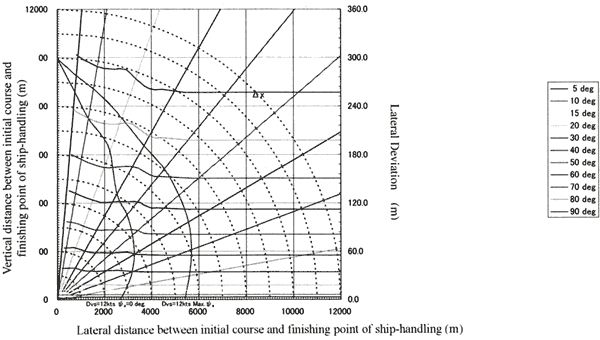|
3. THE INVESTIGATION EXAMPLE OF THE SHIP'S MANEUVERABILITY
It confirmed that fairway design could be carried out by combining the variety maneuvering performances of the ship in the last section. It is used that the numerical simulation can be done easily on the various conditions from grasping the variety ship's maneuverability. In this section, we explain the numerical simulation which is grasped the ship's maneuverability to use the fairway design.
The characteristics of ship-handler, special ship-handling technique such as boosting, ship supporting system such as tug boat and thruster ware removed from the examination object at the numerical simulation for the purpose of to clear the basic performance of the vessel individual. Therefore, the means to use for the ship-handling are only a main engine and a rudder.
3.1 The ship's maneuverability to confirm by the numerical simulation
The numerical simulation which reflected the movement character of the vessel precisely is done, and below ship's maneuverability is grasped to use the fairway design.
1) Course keeping with deceleration performance
The Deceleration performance when going straight is confirmed using the ship control method that it slows down with course keeping when simulation is enforced.
Fig.3 The ship's maneuverability and elements of fairway design
2) Course change (Turning) with deceleration performance
The ship-handler is required slow down engine at the passing fairway cause of the planning fairway with harbor. Own ship control in the numerical simulation is used speed control at the time of course change operation. It is combined the timing of engine control and rudder control. By the way of controlling own ship, as the ship's speed is changed at the start timing of steering from the difference timing of main engine control, it is confirmed that the difference of turning performance at the course change operation.
Furthermore, numerical simulation is carried out independently so that to combine maneuvering performances at the time of fairway designs.
3.2 The example of numerical simulation
The target vessel of the numerical simulation to investigate ship maneuvering characteristics was carried out using the container ship. The container carrier has large wind pressure area which the influence of the wind was often taken.
3.2.1 The condition of external force
Simulation is enforced about the calm condition which becomes a basis. Furthermore, the wind direction and the velocity of the wind were changed, and numerical value simulation was done for investigation of a difference in a result of a ship-handling by the wind pressure influence. Table 3 show the setting condition of external force at simulation.
Table 2 The condition of external force
| |
Course keeping with deceleration performance |
Course change with deceleration performance |
| Wind direction |
Every 10 degree |
Every 30 degree |
| Wind velocity |
5m/s. 10/s. 15m/s |
|
3.2.2 The vessel which is used for the simulation
Table 3 shows the principal particular of over-panama max type container vessel.
3.2.3 The way of deceleration
The numerical simulation is started from Half ahead eng. (12 knots). Engine telegraph is operated in accordance with the slowdown method, and the main engine rotation is decreased step by step. The engine control is used only slow down. So, Astern engine and Ahead engine order during slowdown.
Table 3 Principal particular
| |
Over-panama max type Container Carrier |
| LOA |
299.0m |
| Breadth |
37.0m |
| Depth |
21.8m |
| Draft |
13.04m |
| Gross tonnage |
59.622 ton |
| Engine output |
42.120 PS |
| Eng. Telegraph |
Nav. Full
Ahead |
R.P.M |
77.0 |
| Knots |
23.5 |
| Full Ahead |
R.P.M |
43 |
| Knots |
13.3 |
| Half Ahead |
R.P.M |
39.0 |
| Knots |
12.0 |
| Slow Ahead |
R.P.M |
32.0 |
| Knots |
9.9 |
| D.Slow Ahead |
R.P.M |
27.0 |
| Knots |
8.3 |
| Stop |
0.0 |
| D.Slow Ast'n |
-27.0 rpm |
| Slow Ast'n |
-32.0 rpm |
| Half Ast'n |
-39.0 rpm |
| Full Ast'n |
-43.0 rpm |
|
3.2.4 The bending angle and direction
The bending angle is 5, 10, 15, 20, 30, 40, 50, 60, 70, 80 and 90degrees, and its direction is right.
3.2.5 Rudder angle and steering control
The maximum rudder angle is 35 degrees to use the steering at numerical simulation Ban-ban control is used for the rudder control.
3.2.6 The finish position of ship-handling
If the ships speed is reached 3knots. the simulation is finished.
3.3 The example of numerical simulation
It could get the character of the Course keeping with deceleration performance and Course change with deceleration performance of the target vessel by the numerical simulation. These data is important for the decided fairway shape and width. So, it is necessary to make a database for the fairway design.
Fig. 4 shows the sample of database. This figure is show the result of wind direction: 90 degrees, wind velocity: 5m/s. It is show the lateral deviation and distance from the relation between altering course point and final position of ship-handling.
Fig.4 Fig.4 Sample of result data
The Distance between altering course point and finishing point of ship-handling, lateral deviation |
(Wind Direction; 90deg., Wind Velocity:5m/s, Final Ship Speed;3knots)
(Enlarged Image:48KB) |
 |
|